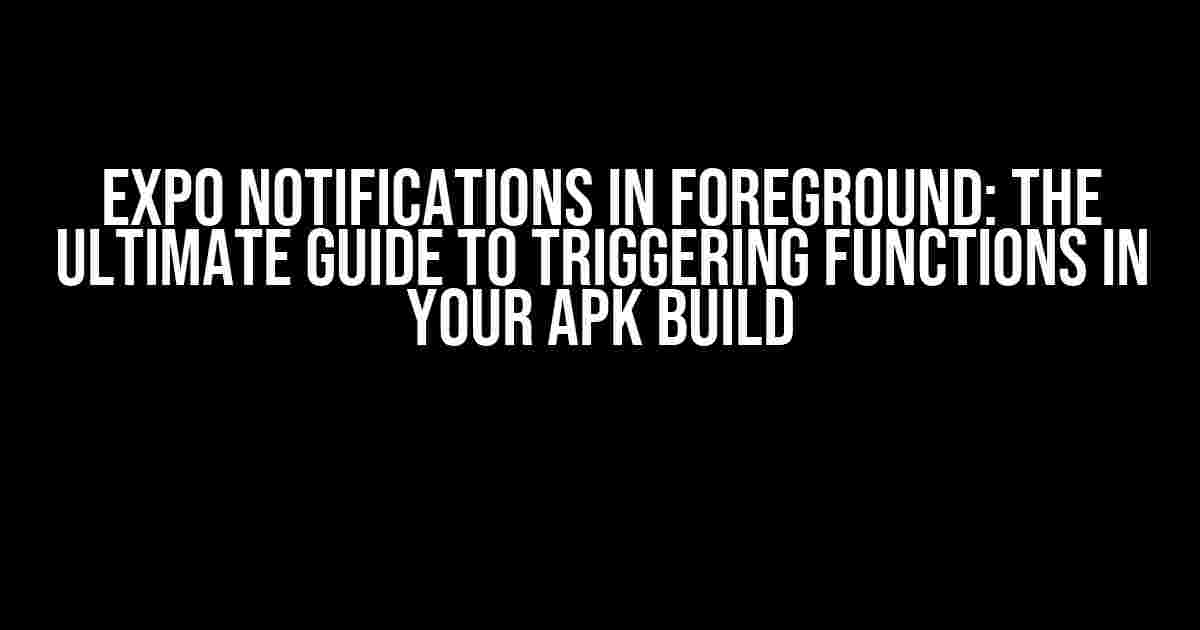Are you tired of struggling with Expo notifications in the foreground? Do you find yourself stuck, wondering why your notification listeners aren’t triggering your functions in your APK build? Worry no more! In this comprehensive guide, we’ll dive into the world of Expo notifications, exploring the common pitfalls and providing you with clear, step-by-step instructions to get your notifications firing on all cylinders.
Understanding Expo Notifications
Before we dive into the meat of the matter, let’s take a step back and understand how Expo notifications work. Expo, a popular framework for building cross-platform apps, provides an efficient way to handle notifications. When a notification is received, Expo triggers an event that can be listened to by your app. This event is where you can execute custom functions, such as updating your app’s state or performing specific actions.
The Issue: Expo Notifications in Foreground Not Triggering Functions
Now, let’s talk about the issue at hand. When your app is in the foreground, Expo notifications might not trigger your functions as expected. This can be frustrating, especially if you’re relying on these notifications to perform critical tasks. So, what’s going on?
- Lack ofproper configuration: One common reason for this issue is the absence of proper configuration in your Expo project. Make sure you’ve correctly set up your notification listeners and handlers.
- Foreground service configuration: When your app is in the foreground, Expo uses a foreground service to handle notifications. If this service is not properly configured, notifications might not trigger your functions.
- AndroidManifest.xml modifications: Modifying the AndroidManifest.xml file incorrectly can also lead to issues with Expo notifications in the foreground.
Solving the Issue: Step-by-Step Instructions
Now that we’ve identified the possible causes, let’s dive into the solutions. Follow these step-by-step instructions to ensure your Expo notifications trigger your functions in the foreground:
Step 1: Configure Your Notification Listeners
In your Expo project, create a new file called `Notifications.js` and add the following code:
import Expo from 'expo';
const notificationListener = Expo.Notifications.addListener((notification) => {
// Your custom function to be triggered
handleNotification(notification);
});
const handleNotification = (notification) => {
console.log('Notification received:', notification);
// Perform your custom actions here
};
Step 2: Configure Your Foreground Service
In your `expo.json` file, add the following configuration:
{
"expo": {
...
"android": {
"foregroundService": {
"notification": {
"title": "Your App Name",
"icon": "./assets/icon.png"
}
}
}
}
}
This configuration sets up a basic foreground service with a notification title and icon.
Step 3: Modify AndroidManifest.xml
In your `android/app/src/main/AndroidManifest.xml` file, add the following code:
<service android:name="expo.modules.notifications.service.NotificationService" android:enabled="true" android:foregroundServiceType="dataSync" />
This code enables the Expo notification service and allows it to run in the foreground.
Troubleshooting Common Issues
Even after following the above steps, you might still encounter some issues. Here are some common problems and their solutions:
Issue 1: Notifications Not Triggering in the Foreground
If notifications are not triggering in the foreground, ensure that:
- Your notification listener is correctly set up and registered.
- Your foreground service is properly configured.
- You’ve modified the AndroidManifest.xml file correctly.
Issue 2: Notifications Triggering Multiple Times
If notifications are triggering multiple times, try:
- Removing the notification listener when it’s no longer needed.
- Using a flag to track whether the notification has already been triggered.
Issue 3: Notifications Not Showing in the Notification Shade
If notifications are not showing in the notification shade, ensure that:
- Your notification configuration is correct (title, icon, etc.).
- You’ve granted the necessary permissions for notifications.
Conclusion
Expo notifications in the foreground can be a bit tricky to set up, but with the right configuration and troubleshooting, you can get them working seamlessly. By following the steps and troubleshooting common issues outlined in this guide, you’ll be well on your way to triggering functions in your APK build. Remember to stay calm, be patient, and don’t hesitate to reach out for help if you need it!
| Configurations | Files Affected |
|---|---|
| Notification Listener | Notifications.js |
| Foreground Service | expo.json |
| AndroidManifest.xml Modifications | android/app/src/main/AndroidManifest.xml |
We hope this comprehensive guide has helped you overcome the hurdle of Expo notifications in the foreground not triggering functions in your APK build. Happy coding!
FAQs:
- Q: What is Expo? Expo is a popular framework for building cross-platform apps.
- Q: Why do Expo notifications not trigger functions in the foreground? Expo notifications might not trigger functions in the foreground due to lack of proper configuration, incorrect foreground service setup, or modifications to the AndroidManifest.xml file.
- Q: How do I troubleshoot Expo notification issues? Troubleshoot Expo notification issues by checking the notification listener configuration, foreground service setup, and AndroidManifest.xml file modifications.
Frequently Asked Question
Hey there, developers! Are you struggling with Expo notifications not triggering functions in your APK build? Don’t worry, we’ve got you covered! Here are the top 5 FAQs to help you troubleshoot the issue:
Why are Expo notifications not triggering my function in the foreground?
This might happen because Expo notifications are handled by the Expo SDK, and when your app is in the foreground, the notification is not passed to your app’s notification handler. Try using the `setForegroundNotificationFactory` function from the `expo-notifications` module to customize the notification handler.
Do I need to add any permissions to my AndroidManifest.xml file?
Yes, you need to add the `android.permission.WAKE_LOCK` permission to your AndroidManifest.xml file to ensure that your app can receive notifications while running in the foreground.
How can I debug Expo notifications in my APK build?
You can use the `expo-notifications` module’s `addListener` function to listen for notification events and log them to the console. This will help you identify any issues with your notification handler.
Can I use Expo notifications with other push notification services?
Yes, Expo notifications can be used with other push notification services like Firebase Cloud Messaging (FCM) or Google Cloud Messaging (GCM). However, you’ll need to implement the necessary integrations and handle the notification logic accordingly.
What if I’m still having issues with Expo notifications in my APK build?
If you’ve tried the above solutions and are still facing issues, try checking the Expo documentation and GitHub issues for similar problems. You can also reach out to the Expo community or seek help from a developer forum for further assistance.


